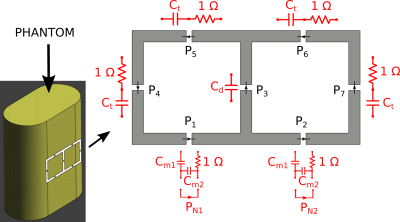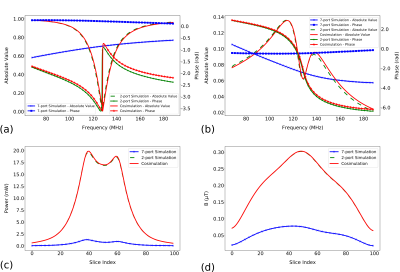3220
CoSimPy: an Open-Source Python Library for MRI RF Coil EM/Circuit Cosimulation1Istituto Nazionale di Ricerca Metrologica (I.N.Ri.M.), Torino, Italy, 2Physikalisch-Technische Bundesanstalt (PTB), Braunschweig and Berlin, Germany
Synopsis
The Electromagnetic/Circuit cosimulation method represents an effective strategy to address those problems where a radiative structure has to interact with external supporting circuitries.This method proved to be particularly valuable for MRI RF coil design where the supporting circuitry optimisation is generally of particular concern. CoSimPy, an open-source library conceived for Electromagnetic/Circuit cosimulations, is presented. CoSimPy is written in Python following an Object-oriented programming. This improves its scalability and easily allows interested scientists to collaborate, integrating and improving the library with other methods. CoSimPy is available under https://github.com/umbertozanovello/CoSimPy together with a detailed documentation providing guidelines and examples.
INTRODUCTION
Electromagnetic (EM) simulation tools represent a fundamental resource in MRI RF coil design, allowing for preliminary evaluations of the behaviour of a specific RF coil topology and configuration1-3. In this regard, radiative elements closely interact with supporting circuitries defining the final performance of a device. Optimising the values of the lumped elements involved in the supporting circuitry is generally a key point of the RF coil design procedure4,5. In principle, EM simulations have to be repeated for each tuning, matching and decoupling condition, since each lumped element value has to be optimised to obtain the targeted RF coil behaviour. However, due to the significant computational demand of such simulations, this does not represent a practical procedure. EM/Circuit cosimulation appears to be an effective strategy to address such limitations6-9. In this approach, a multiport EM simulation is performed involving only the radiative parts of the RF coil. In a separate environment, each port is replaced by the relevant circuitry and the S matrix of the connected RF coil, together with the generated EM field, can be efficiently recomputed. In this abstract, CoSimPy, an open-source Python library developed for harmonic EM/circuit cosimulations, is presented. With respect to existing available implementations10, CoSimPy is completely Python-based, addresses some of the limitations of those tools and embeds methods aimed to characterise an RF coil performance and to simplify and accelerate the standard design workflow. CoSimPy is written following an Object-oriented programming improving its scalability and its ease of integration in homemade Python codes. CoSimPy is available on the GitHub repository (https://github.com/umbertozanovello/CoSimPy) together with a comprehensive documentation detailing the different methods, providing examples and guidelines for the installation.METHODS
In Figure 1 the basic framework of the library is sketched with solid black lines. RF_Coil is the main class of the library representing the simulated multiport device. An RF_Coil instance has two properties: s_matrix and em_field. Such properties are instances of the S_Matrix and EM_Field classes, respectively. The former is responsible for storing the S matrix of the simulated device, managing all the operations which can involve such a matrix (e.g. connection with external circuitries). The latter class is responsible for storing and managing the EM fields generated by the RF coil. The red dashed lines in Figure 1 sketch the flow of the connection between the RF coil and a generic external network, represented by an RF_Coil and S_Matrix instance respectively. When a connection is performed, the RF_Coil instance calls a proper method of the S_Matrix class returning the new S_Matrix instance relevant to the connected RF coil and an array of complex coefficients, P_inc. Such coefficients are used by a method defined in the EM_field to obtain the new EM_field instance associated with the connected RF coil. Both the obtained S_Matrix and EM_Field instances become the properties of the new RF_Coil instance representing the connected RF coil.RESULTS
The reliability of the cosimulation algorithm has been tested against a full-wave simulation performed with Sim4Life11 and involving the reference setup of Figure 2. A 7-port simulation has been performed over a frequency bandwidth equal to ±60 MHz with a central frequency equal to 128 MHz. The computed S matrix of the RF coil has been extracted together with the electric field and magnetic flux density distributions inside the phantom. Each simulated port has then been connected, in the circuit simulation environment, to the circuitries shown in Figure 2. The values of the four capacitors which maximised the total power accepted by the PN1 and PN2 ports have been investigated through a genetic optimisation algorithm12 and resulted in: Ct = 22 pF, Cd = 41 pF, Cm1 = 240 pF and Cm2 = 38 pF. In Figure 3, the behaviour of the 2-port RF coil obtained in the circuit simulation environment has been compared with the outcomes obtained simulating the same 2-port device in Sim4Life, both in terms of S parameters and EM field distribution.DISCUSSION AND CONCLUSION
The matching between the results obtained from the circuit simulation environment and the 2-port simulation demonstrates the reliability of the library implementation. Along with the fundamental methods described above, many others have been developed both to simplify and accelerate the standard RF coil design workflow. Examples includes methods for importing and exporting the EM field distribution, importing the S parameters from a Touchstone file, computing voltages and currents at the RF coil ports and the power balance of the RF coil. CoSimPy is under constant development and many other methods are being implemented and will be available in the future versions of the library. The main idea supporting the development of CoSimPy is to provide a free and handy tool to perform RF coil EM/Circuit cosimulations also complementing existing EM simulation tools13-15 already pursuing the "open-source imaging" philosophy16 and other commercial tools where a circuit simulation interface is still missing17. Finally, CoSimPy also wants to represent a coworking environment where scientists can implement additional methods whose sharing can represent an advantage for the community.Acknowledgements
This project (RMG: 17IND01-RMG1 MIMAS) has received funding from the EMPIR programme co-financed by the Participating States and from the European Union’s Horizon 2020 research and innovation programmeReferences
- Frass-Kriegl R, Hosseinnezhadian S, Poirier-Quinot M, et al. Multi-Loop Radio Frequency Coil Elements for Magnetic Resonance Imaging: Theory, Simulation, and Experimental Investigation. Frontiers in Physics. 2020; 7: 237.
- Lemdiasov R. A, Aghogho A. O, and Reinhold L. A numerical postprocessing procedure for analyzing radio frequency MRI coils. Concepts in Magnetic Resonance Part A. 2011; 38A(4): 133-147.
- Elabyad I. A, Terekhov M, Stefanescu M. R, et al. Design and Evaluation of a Novel Symmetric Multichannel Transmit/Receive Coil Array for Cardiac MRI in Pigs at 7 T. IEEE Transactions on Microwave Theory and Techniques. 2019; 67(9): 3928-3945.
- Morze C, Tropp J, Banerjee S, et al. An eight‐channel, nonoverlapping phased array coil with capacitive decoupling for parallel MRI at 3 T. Concepts in Magnetic Resonance Part B. 2007; 31: 37-43.
- Dieringer M. A, Renz W, Lindel T, et al. Design and application of a four-channel transmit/receive surface coil for functional cardiac imaging at 7T. J Magn Reson Imaging. 2011; 33(3): 736-41.
- Kozlov M, Turner R, Fast MRI coil analysis based on 3-D electromagnetic and RF circuit co-simulation. J Magn Reson 2009; 200(1): 147–152.
- Seifert F, Cassara A, Weidemann G, B. Ittermann, Reliable and robust rf safety assessment of transmit array coils at ultrahigh fields. ISMRM Scientific Annual Meeting Proceedings, ISMRM. 2014.
- Sadeghi-Tarakameh A, Kazemivalipour E, Gundogdu U, et al. Accelerating the cosimulation method for the design of transmit array coils for mri. Magnetic Resonance Materials in Physics, Biology and Medicine. 2020; 34(06): 165–178.
- Li N, Liu S, Hu X, et al. Electromagnetic field and radio frequency circuit co-simulation for magnetic resonance imaging dual-tuned radio frequency coils. IEEE Transactions on Magnetics. 2018; 54(3): 1–4.
- Beqiri A, Hand J. W, Hajnal J. V, Malik S. J. Comparison between simulated decoupling regimes for specific absorption rate prediction in parallel transmit mri. Magnetic Resonance in Medicine. 2015; 74(5): 1423–1434.
- Z. M. Tech. Sim4life. https://zmt.swiss/. Accessed November 3, 2021.
- Solgi R. Genetic Algorithm Package for Python. Github. https://github.com/rmsolgi/geneticalgorithm/. Accessed November 3, 2021
- Villena J. F, Polimeridis A. G, Eryaman Y, et al. Fast electromagnetic analysis of mri transmit rf coils based on accelerated integral equation methods,” IEEE Transactions on Biomedical Engineering. 2016; 63(11): 2250–2261,
- Guérin B, Villena J. F, Polimeridis A. G, et al. Computation of ultimate sar amplification factors for radiofrequency hyperthermia in non-uniform body models: impact of frequency and tumour location,” International Journal of Hyperthermia. 2018; 34(1): 87–100.
- Liebig T, Rennings A, Held S, Erni D. openems – a free and open source equivalent-circuit (ec) fdtd simulation platform supporting cylindrical coordinates suitable for the analysis of traveling wave mri applications. International Journal of Numerical Modelling: Electronic Networks, Devices and Fields. 2013; 26(6): 680–696.
- opensourceimaging. https://www.opensourceimaging.org/. Accessed November 3, 2021.
Figures


